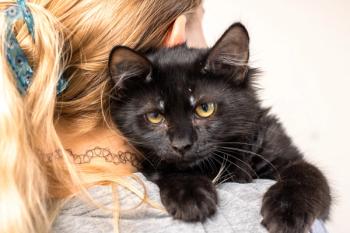Ninety percent of cats with hyperthyroidism have an elevated TT4, and this, combined with compatible clinical signs and a palpable cervical mass, typically confirms the diagnosis. The increase in TT4 correlates with the duration of disease and not thyroid gland size.3,4 The longer the disease duration, the higher the TT4. With early diagnosis of hyperthyroidism, TT4 elevation is less extreme, and TT4 may be normal.
There are several reasons why a cat with hyperthyroidism may have a normal TT4. First is the normal daily variability of thyroxine (T4) levels in both normal and hyperthyroid cats.5 In addition, nonthyroidal illness can affect thyroid testing results both directly and indirectly. Hypoproteinemia may result in a direct decrease in measured TT4 levels due to decreased protein-bound thyroid hormone availability to the assay. Further, nearly any chronic illness can cause thyroid hormone suppression, decreasing a mildly elevated thyroid into the high-normal or even normal range.
Free T4
A highly sensitive test (98.5%), the free T4 (FT4) assay can be used to rule out hyperthyroidism with confidence. However, research has shown that FT4 can either decrease or increase in cats with nonthyroidal illness. Thus, FT4 measurement should not be used as the sole test to confirm hyperthyroidism.6 This is particularly important to remember for practitioners using both TT4 and FT4 tests for routine screening. In other words, although an elevated TT4 and FT4 is consistent with a diagnosis of hyperthyroidism, a normal or borderline TT4 with a high FT4 is not diagnostic for hyperthyroidism and requires additional testing. FT4 measured by equilibrium dialysis (FT4ED) is preferred over other types of FT4 assays, although equilibrium dialysis has become less available than previously.
Thyroid-stimulating hormone
In human medicine, serum thyroid-stimulating hormone (TSH) levels are used for routine thyroid monitoring. TSH is secreted from the pituitary, where it acts on the thyroid gland to increase circulating thyroid hormone. Regulated by a negative feedback loop, TSH secretion decreases in response to increased circulating thyroid hormone levels. In hyperthyroidism, which is caused by autonomous secretion of thyroid hormone, TSH should be very low. In fact, TSH values compatible with hyperthyroidism in cats are below the lower limit for quantification in current commercially available canine TSH (cTSH) assays. Using available cTSH assays, researchers found that some cats with an undetectable cTSH level without clinical signs or thyroid hormone elevations went on to develop clinical hyperthyroidism within about 1 year.7
Study results by Peterson et al also showed that cTSH levels were too low to measure (<0.03 ng/mL) in 98% of hyperthyroid cats compared with low but measurable values in normal cats and cats with euthyroid sick syndrome. The cTSH assay cannot reliably differentiate between normal and euthyroid sick cats and cannot be used as a sole diagnostic test for feline hyperthyroidism. However, accurate diagnosis can be achieved in over 98% of cases by combining the results of cTSH with TT4 and FT4ED.8
Feline specific TSH
A feline-verified TSH (fTSH) test has recently been developed and integrated into a point-of-care diagnostic system. Truforma (Zomedica) is expected to launch in late March and delivers test results within 20 minutes. The lower limit for detecting fTSH is 0.008 ng/mL compared with 0.03 ng/mL for the currently available cTSH assay.9 The increased diagnostic sensitivity in this important low range should allow for better characterization of the feline thyroid patient and may allow for differentiation of hyperthyroid, normal thyroid, and euthyroid sick cats. Clinical studies to investigate this further are currently underway. The fTSH test may replace FT4/FT4ED for confirmation of hyperthyroidism in cats.
The clinical implications of varying thyroid panel results are listed in Table 1.
Clinical implications
The best diagnostic and treatment decisions are made when the clinician evaluates all available data. In veterinary medicine, this process should combine the signalment, history, physical examination findings, and individualized interpretation of the laboratory test results relative to each patient. In hyperthyroidism, monitoring and treatment decisions often depend on the clinician’s suspicion of the likelihood of disease.
What is a high clinical suspicion?
Determining clinical suspicion
Answer these yes/no questions to help determine the clinical suspicion for hyperthyroidism in your feline patients. Clinical suspicion should increase with the number of “yes” answers and decrease with the number of “no” answers.
- Is the cat over age 8? There is only a 5% chance of hyperthyroidism in a cat younger than 8 years.
- Is the thyroid nodule palpable? About 80% of cats with hyperthyroidism have a palpable thyroid nodule, even though about 20% of cats with a cervical mass are not hyperthyroid.
- Is the cat in poor body condition? Overt hyperthyroidism would be atypical in overweight or obese patients, but occult hyperthyroidism cannot be ruled out.
- If the cat is thin or has poor body condition, is its appetite maintained? There are few differentials for weight loss and decreased body condition in a cat with a normal or increased appetite.
- Is the cat’s alanine aminotransferase(ALT) elevated? Most hyperthyroid cats have increased ALT levels (+/- alkaline phosphatase).
As noted, hyperthyroidism is a disease of older cats. Weight loss and a decreased body condition score are the most common presenting complaints. Notably, weight loss in cats despite a good appetite arises from a short list of possible differentials, including hyperthyroidism, diabetes mellitus, exocrine pancreatic insufficiency, and severe malabsorption/maldigestion GI tract disease. The astute clinician recognizes the ability to narrow down these differentials with routine lab work, including a TT4. The finding of mild to moderate ALT elevation with otherwise normal lab work should prompt thyroid hormone testing, particularly in a cat over 8 years old. Additional GI tract investigation can be performed once the other differentials have been excluded (eg, GI panel with trypsin-like immunoreactivity, abdominal ultrasound histopathology). The presence or absence of a palpable cervical mass might sway the clinical suspicion toward the higher or lower end. Previously published diagnostic schemes have separated cases into categories based on clinical signs, physical exam, and T4.10 (See “Determining clinical suspicion”.)
When test results are “on the border”
Borderline thyroid hormone test results are typically classified as a TT4 in the upper one-third of the reference interval. Reference intervals are assay dependent, and test results should be interpreted within the known reference interval of the assay. Nonetheless, researchers have shown that a TT4 over 3.5 µg/dL is a statistical outlier that should be evaluated further.6 If clinical suspicion is high, the patient’s thyroid hormone status should be investigated, regardless of the initial T4 result.
When clinical suspicion is high, add a measurement of FT4/FT4ED and TSH (or, ideally, fTSH if available). If lab tests cannot be added, then repeat testing is encouraged. In most cases, hyperthyroidism is not an emergency, and repeat testing can be performed within 1 to 4 weeks. Urgency may increase in cases of apathetic hyperthyroidism with significant concurrent nonthyroidal illness. A borderline TT4, high FT4/FT4ED, and immeasurable cTSH are consistent with subclinical or occult hyperthyroidism.
If clinical suspicion is low, consider rechecking TT4 immediately or in several months. If normal, clinically significant hyperthyroidism can be ruled out. If borderline, the full thyroid panel is recommended at that time.
Neither subclinical nor occult hyperthyroidism is an emergency. Careful monitoring of body weight, body condition, cervical palpation, and heart rate with repeat thyroid hormone testing is appropriate in stable cats at risk for subclinical or occult hyperthyroidism. This wait-and-watch approach allows for monitoring of disease progression without jeopardizing patient health.
Summary
Feline hyperthyroidism is a common disease of geriatric cats. Although in most cats, the condition can be diagnosed based on history, physical exam findings, and results of a single TT4 test, a small but important number of cats require a more extensive workup, including measurement of the complete thyroid hormone panel. A new feline specific TSH assay should help improve the diagnosis and management of complex cases and may allow for earlier diagnosis of disease and more precise therapy management.
Heather L. Kvitko-White, DVM, DACVIM, is the founder of KW Veterinary Consulting. As an industry activist, writer, and national speaker, she promotes a creative and common-sense approach to caring for animals without sacrificing quality. Kvitko-White volunteers her spare time with the ACVIM, the Collaborative Care Coalition, and mentoring veterinary students.
References
- Peterson ME. Animal models of disease: feline hyperthyroidism: an animal model for toxic nodular goiter. J Endocrinol. 2014;223(2):T97-114. doi:10.1530/JOE-14-0461
- Feldman EC, Nelson RW. Canine and Feline Endocrinology and Reproduction, 3rd ed. Elsevier; 2014.
- Wehner A, Koehler I, Ramspott S, Hartmann K. Relationship between total thyroxine, thyroid palpation and a clinical index in hyperthyroid and healthy cats and cats with other diseases. J Feline Med Surg. 2019;21(8):741-749. doi:10.1177/1098612X18799462
- Jordan A, Gray R, Terkildsen M, Krockenberger M. Biological variation of total thyroxine (T4), free T4 and thyroid-stimulating hormone in 11 clinically healthy cats. J Feline Med Surg. Published online November 11, 2020. doi:10.1177/1098612X20969485
- Lottati M, Aucoin D, Bruyette DS. Expected total thyroxine (TT4) concentrations and outlier values in 531,765 cats in the United States (2014-2015). PLoS One. 2019;14(3):e0213259. doi:10.1371/journal.pone.0213259
- Mooney CT, Little CJ, Macrae AW. Effect of illness not associated with the thyroid gland on serum total and free thyroxine concentrations in cats. J Am Vet Med Assoc. 1996;208(12):2004-2008.
- Wakeling J, Elliott J, Syme H. Evaluation of predictors for the diagnosis of hyperthyroidism in cats. J Vet Intern Med. 2011;25(5):1057-1065. doi:10.1111/j.1939-1676.2011.00790.x
- Peterson ME, Guterl JN, Nichols R, Rishniw M. Evaluation of serum thyroid-stimulating hormone concentration as a diagnostic test for hyperthyroidism in cats. J Vet Intern Med. 2015;29(5):1327-1334. doi:10.1111/jvim.13585
- Wood A, Ryder M, Harmon I, Wegner C. TRUFORMATM point-of-care canine and feline thyroid-stimulating hormone (TSH) assay. Zomedica. Accessed February 2, 2021. http://docplayer.net/186018371-Thyroid-stimulating-hormone-tsh-assay.html
- Carney HC, Ward CR, Bailey SJ, et al. 2016 AAFP guidelines for the management of feline hyperthyroidism. J Feline Med Surg. 2016;18(5):400-416. doi:10.1177/1098612X16643252







